If you’re looking for the best trail running shoes in 2025, I recommend checking out options like the Saucony Excursion TR14 for light trails and casual wear, the New Balance Garoé V2 for rugged terrains, and the Brooks Cascadia 18 for challenging mountain trails. The Under Armour Charged Maven and New Balance 410 V8 are stylish and versatile, while the Dynasoft Nitrel V6 offers lightweight support. Keep exploring to find the perfect fit for your adventure needs.
Key Takeaways
- Choose shoes with rugged, multidirectional lugs for superior traction on diverse terrains, including mud, rocks, and steep slopes.
- Prioritize models with supportive cushioning and a secure fit to enhance comfort and stability during long trail runs.
- Select footwear with durable construction and abrasion-resistant materials for prolonged use in challenging outdoor conditions.
- Consider breathability and moisture-wicking features for comfort during extended runs in variable weather.
- Match shoe design to terrain type—deep lugs for muddy trails, lightweight support for rocky paths, and versatile soles for mixed surfaces.
Saucony Mens Excursion Tr14 Trail Running Shoe
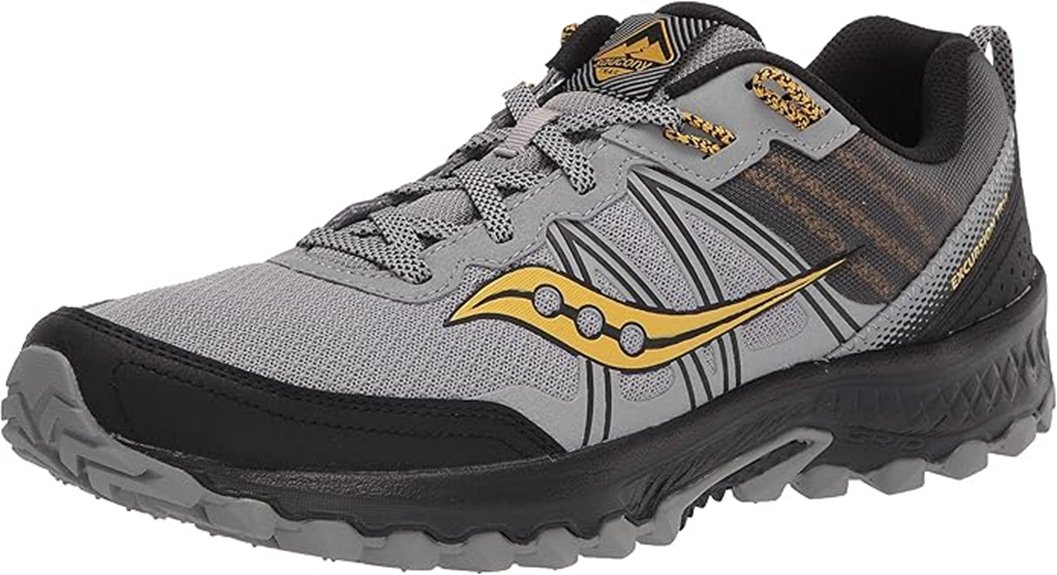
If you’re looking for a dependable trail running shoe that can handle everyday outdoor activities, the Saucony Mens Excursion TR14 is an excellent choice. It offers solid cushioning, rugged traction, and durable protection, all wrapped in a sleek, versatile design. The shoe is lightweight, true to size, and easy to slip on, making it perfect for casual wear or light trail adventures. Many users find it comfortable for long walks and daily tasks, especially on flat surfaces. Its reliable grip and sturdy build ensure it performs well over time, and its stylish look means you won’t have to sacrifice fashion for function.
Best For: individuals seeking a lightweight, comfortable, and durable trail shoe for casual outdoor activities, walking, or light trail adventures.
Pros:
- Excellent cushioning and support for long walks and daily wear
- Rugged traction suitable for light trail use and everyday surfaces
- Stylish, versatile design available in multiple color options
Cons:
- Less effective grip on rough rocky or screed surfaces
- Wear around the heel area can expose internal materials over time
- Not ideal for intense trail running or rugged mountain terrains
New Balance Mens Fresh Foam X Garoé V2 Trail Running Shoe
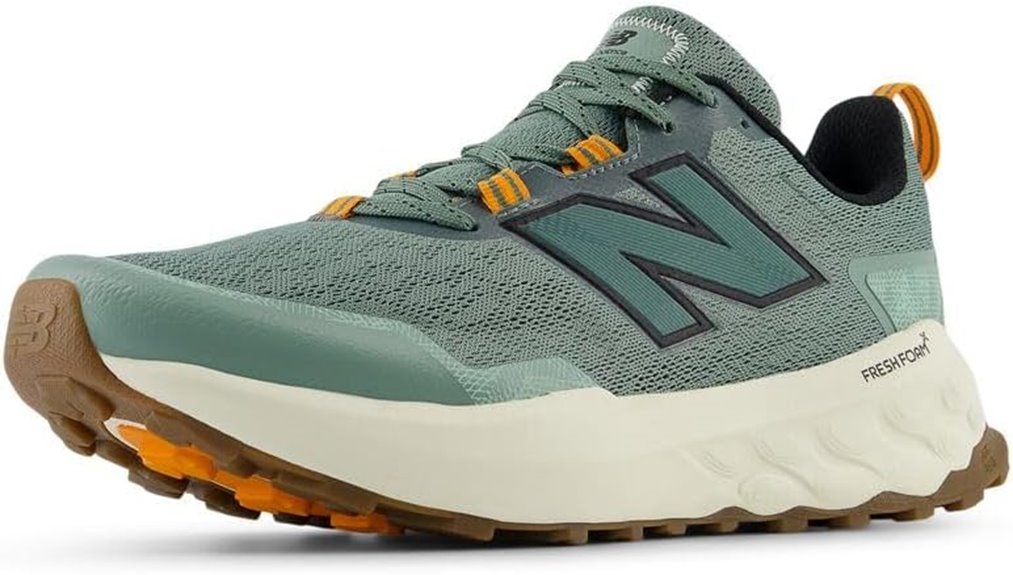
The New Balance Mens Fresh Foam X Garoé V2 Trail Running Shoe stands out as an ideal choice for trail runners who prioritize both comfort and reliable traction on challenging terrains. Its dual-density Fresh Foam X cushioning delivers plush comfort while maintaining stability, perfect for long runs or uneven surfaces. The Vibram® outsole, with revamped tread patterns and deeper 6mm lugs, offers exceptional grip on diverse terrains. The breathable knit upper and gusseted tongue protect against debris and water, ensuring comfort in unpredictable conditions. Built for durability and performance, this shoe confidently handles rugged trails, making it a dependable option for outdoor enthusiasts.
Best For: trail runners seeking a versatile, comfortable shoe with excellent traction and durability for challenging terrains.
Pros:
- Dual-density Fresh Foam X cushioning offers a balance of plush comfort and stability
- Vibram® outsole with deeper 6mm lugs provides superior grip on various surfaces
- Breathable knit upper and gusseted tongue protect against debris and water
Cons:
- May be less suitable for road running due to aggressive trail outsole
- Slightly heavier compared to minimalist trail shoes
- The more technical features might require an adjustment period for new users
Under Armour Mens Charged Maven Trail Running Shoe
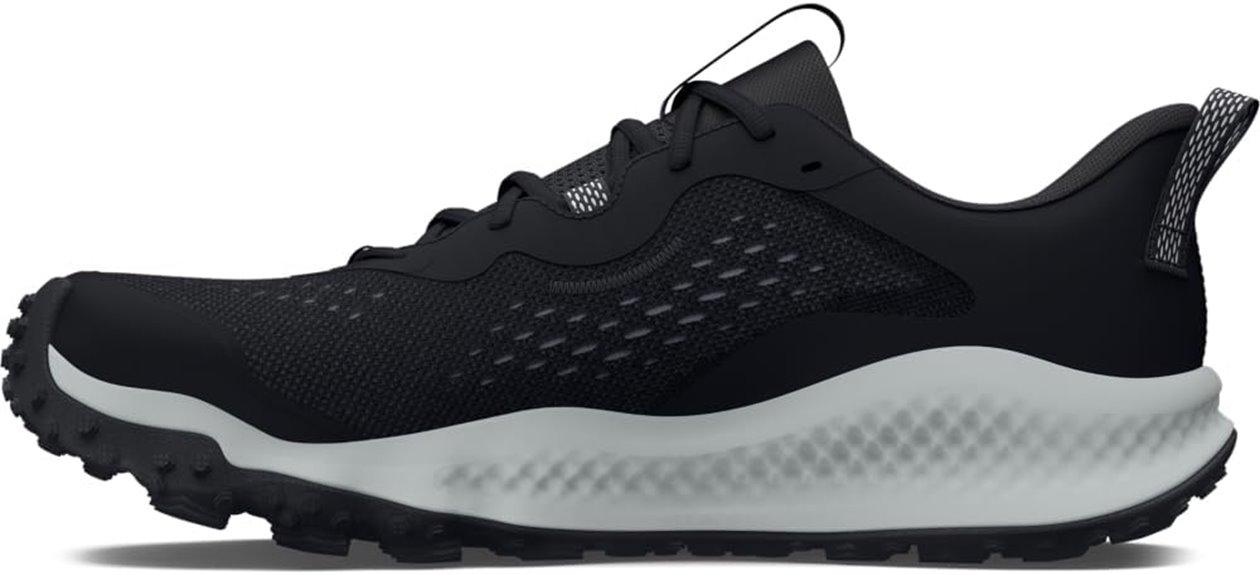
Designed for versatility and durability, the Under Armour Mens Charged Maven Trail Running Shoe excels whether you’re hitting rugged trails, urban streets, or walking all day. Its engineered mesh upper keeps it lightweight and breathable, while PU overlays add protection in high-wear areas. The Deluxe Comfort System sockliner molds to your foot for all-day comfort. The Charged Cushioning® midsole offers responsiveness and durability, and the rubber outsole with omni-directional trail lugs provides excellent traction on various terrains. Available in stylish colors like Coyote Brown and peanut butter brown, these shoes are perfect for hiking, walking, or city adventures, combining comfort, grip, and durability.
Best For: outdoor enthusiasts, hikers, and active individuals seeking durable, comfortable trail shoes for hiking, walking, and city adventures.
Pros:
- Lightweight, breathable engineered mesh upper for all-day comfort and ventilation
- Excellent traction with rubber outsole and omni-directional trail lugs suitable for various terrains
- Durable construction with PU overlays and sturdy design that holds up in high-abrasion areas
Cons:
- Some users may find the fit narrow, especially around the front, causing discomfort
- The shoes may feel too firm for those preferring a softer sole for certain activities
- Limited color options may not suit everyone’s style preferences
New Balance Mens 410 V8 Trail Running Shoe
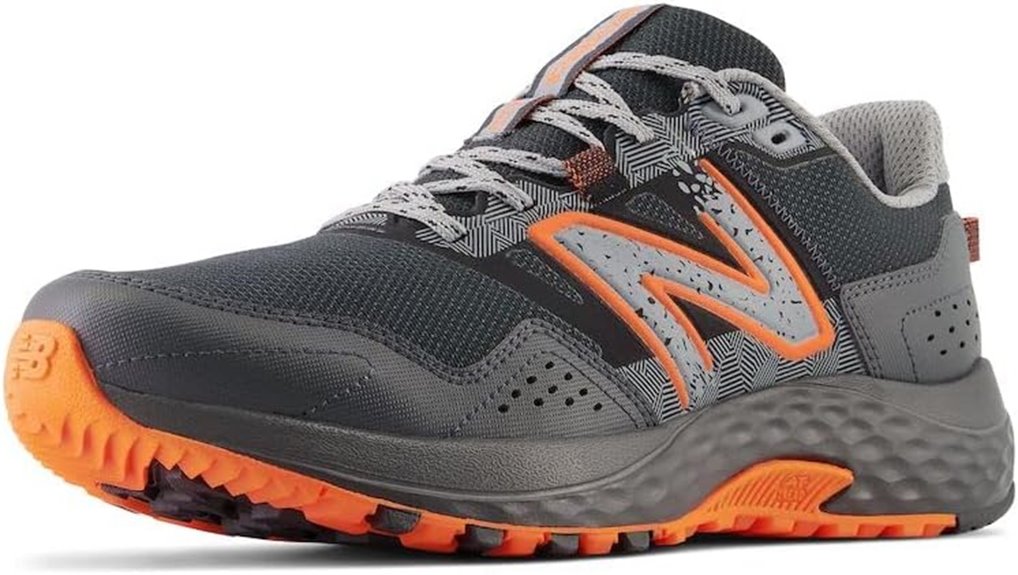
Looking for a trail running shoe that can handle rugged terrain without sacrificing comfort? The New Balance 410 V8 offers just that. Its AT Tread outsole provides reliable traction on and off the trail, while the soft BIO Foam midsole keeps your feet comfortable during long runs or hikes. Made from breathable mesh and durable overlays, it’s lightweight and versatile for trail running, scrambling, or casual wear. Perfect for those with fallen arches, these shoes deliver support, durability, and a classic look. Most find the fit true to size, and many appreciate their support and lasting comfort, making them a solid choice for any terrain.
Best For: trail runners, hikers, and outdoor enthusiasts seeking durable, comfortable footwear with reliable traction on rugged terrains.
Pros:
- Excellent traction with AT Tread outsole suitable for on and off-road surfaces
- Comfortable fit with soft BIO Foam midsole and breathable mesh materials
- Supportive design ideal for individuals with fallen arches and extended wear
Cons:
- Some users experience mismatched fit between shoes despite same size labels
- Recent molds may run tighter or longer, affecting fit for some customers
- Packaging inconsistencies such as damaged boxes or shoes with pet hair reported by a few buyers
New Balance Mens Dynasoft Nitrel V6 Trail Running Shoe
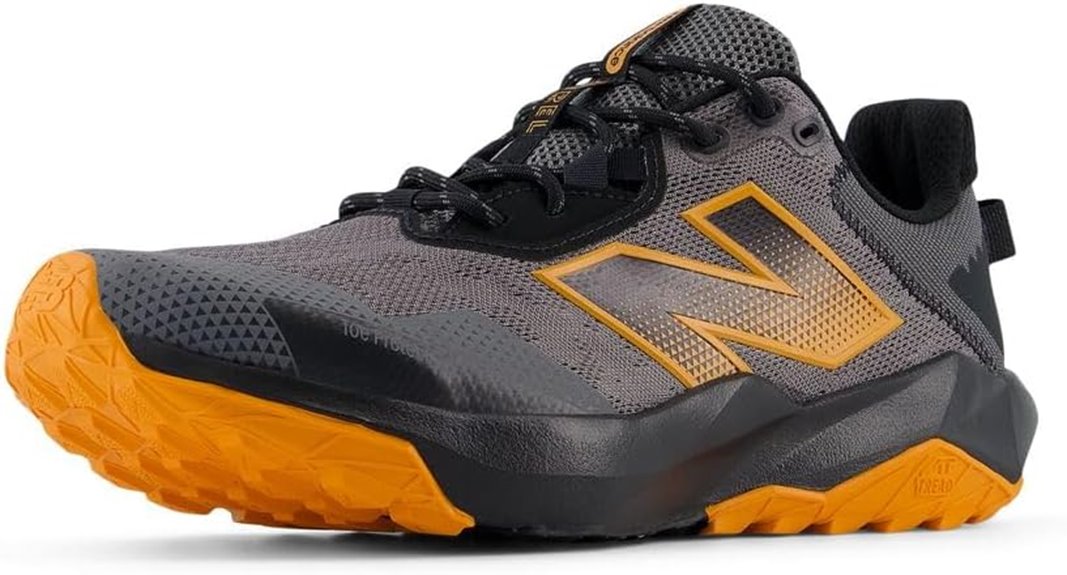
If you’re searching for a trail running shoe that combines durability, comfort, and style, the New Balance Mens Dynasoft Nitrel V6 stands out as a top choice in 2025. Its sleek, edgy design pairs well with both trail and everyday wear, featuring a new lace system that guarantees a secure fit. The shoes feel like walking on pillows, offering lightweight support for long hikes or runs. The slightly stiff toe box provides added protection without sacrificing mobility, while the aggressive grip on dirt and trails keeps you confident on rugged terrain. Durable and versatile, these shoes deliver great value and style, making them a reliable go-to for outdoor adventures.
Best For: outdoor enthusiasts and trail runners seeking durable, comfortable, and stylish shoes for rugged terrain and everyday wear.
Pros:
- Highly durable and resistant to wear, lasting over two months with minimal signs of use
- Excellent comfort, often described as walking on pillows, with a supportive and lightweight feel
- Improved lace system provides a secure, even fit and enhanced sliding control
Cons:
- Slightly stiff toe box may restrict some mobility or cause discomfort for sensitive feet
- Some users suggest sizing up for extra toe room, which may require trying multiple sizes
- The toe area wrapping might feel a bit stiff initially, especially for those accustomed to more flexible shoes
Brooks Men’s Cascadia 18 Mountain Trail Running Shoe
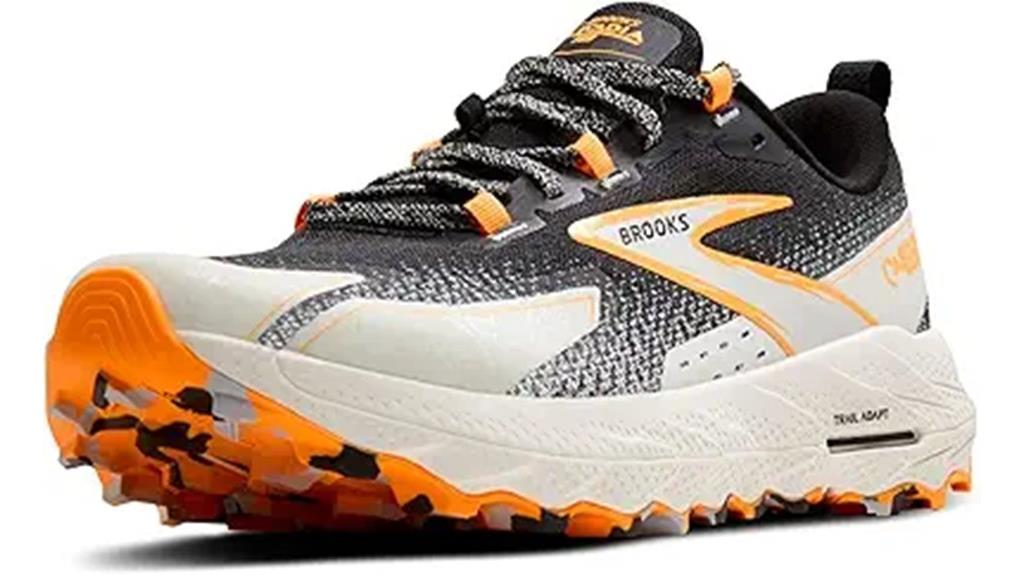
For trail runners and outdoor enthusiasts who demand reliable traction and support across diverse terrains, the Brooks Men’s Cascadia 18 Mountain Trail Running Shoe stands out as an excellent choice in 2025. It handles everything from packed dirt to rocky, muddy, and steep slopes with impressive grip, keeping me stable on slick roots and loose gravel. Right out of the box, it feels comfortable, supportive, and well-cushioned, with a roomy toe box and reinforced protection. Durable enough for extended trail miles, it performs well in various outdoor conditions, though the sole may wear faster on asphalt. Overall, it’s a versatile, high-performance shoe for serious trail adventures.
Best For: trail runners and outdoor enthusiasts seeking reliable traction, support, and durability across diverse terrains during long hikes and trail runs.
Pros:
- Excellent traction and stability on varied surfaces including loose gravel, slick roots, and uneven ground
- Comfortable fit with supportive cushioning, roomy toe box, and reinforced toe protection
- Durable construction suitable for extended trail miles and rugged outdoor conditions
Cons:
- Sole may wear faster on asphalt or concrete due to softer material
- Slightly heavier weight compared to some trail shoes, which may affect agility for some users
- Fit can vary slightly, with some users experiencing a larger fit or heel slippage
Factors to Consider When Choosing Trail Running Shoes Men

When choosing trail running shoes, I focus on traction and grip to prevent slips, ensuring stability on uneven terrain. Comfort and fit are also vital so I can run longer without discomfort, while proper cushioning supports my joints. Additionally, I consider durability and terrain compatibility to find shoes that hold up and perform well on different surfaces.
Traction and Grip
A key factor in choosing the right trail running shoes is their traction and grip, which determine how well you can stay stable on uneven and loose surfaces. For this, I look for a rugged outsole with multidirectional lugs that provide solid grip on challenging terrain. Deep lugs, usually 6mm or more, boost traction on mud, gravel, and rocky paths, making sure I don’t slip. A well-designed outsole pattern helps maintain contact, especially when surfaces are wet or slick. Reinforced toe caps and textured soles add extra grip and protection, essential when scrambling over rocks or climbing steep inclines. The outsole material, like high-abrasion rubber, also plays a critical role in durability and consistent traction, ensuring my shoes perform reliably over time.
Fit and Comfort
Ensuring a proper fit is crucial for trail running shoes, as it directly impacts comfort and performance on uneven terrain. A good fit means enough space in the toe box to prevent blisters and discomfort during long runs. A snug but not tight fit around the heel keeps your foot secure, reducing slipping on downhill sections. Shoes with a supportive midsole absorb shock and lessen fatigue, making longer runs more comfortable. Breathable uppers help maintain airflow, keeping your feet cool and dry, and preventing hot spots. Adjustable lacing systems can fine-tune fit, accommodating different foot shapes for maximum stability. Overall, prioritizing fit and comfort ensures your shoes support your runs, reducing soreness and injury risk while enhancing your trail experience.
Cushioning Support
Choosing the right cushioning support is essential because it directly affects how your feet absorb impact and maintain stability on uneven trails. Adequate cushioning reduces strain on your joints, especially on rocky or technical terrain, helping prevent fatigue. Supportive cushioning also enhances stability, giving you confidence on tricky surfaces. I look for shoes with dual-density foam or specialized midsoles that strike a balance between comfort and support, tailored to my foot type. Proper cushioning adapts to different trail surfaces—offering extra protection on hard-packed dirt and softer ground. However, I avoid overly soft cushioning, which can compromise stability, and overly firm options that cause discomfort. Finding that perfect balance ensures I stay comfortable and secure during every run.
Durability and Build
Durability is crucial when selecting trail running shoes, especially since rough terrain and repeated impacts can quickly wear out inferior materials. I look for shoes with tough outsoles made from high-quality rubber with aggressive tread patterns, offering both grip and resistance to wear. Reinforced toe caps and heel counters are essential, protecting against abrasions from rocks and roots while extending the shoe’s lifespan. I also favor models with double stitching, reinforced overlays, and abrasion-resistant fabrics—these features prevent tearing and damage over time. It’s a balance between durability and weight; well-constructed shoes shouldn’t be heavy but must withstand tough conditions. The right build ensures my shoes stay in good shape, providing reliable performance mile after mile on rugged trails.
Terrain Compatibility
Selecting the right trail running shoes depends heavily on the terrain you’ll encounter, since different surfaces demand specialized features. For loose gravel and mud, aggressive lugs are essential for traction, while smoother soles work better on packed dirt or pavement. Waterproof or water-resistant shoes are vital for wet or muddy trails, keeping your feet dry and comfortable. Traction is also key; deeper, more prominent lugs and specific rubber compounds improve grip on uneven or slippery surfaces. Rugged trails often require reinforced toe caps and protective overlays to guard against rocks, roots, and debris. Additionally, the shoe’s midsole cushioning and support should match the terrain — offering stability on uneven ground and comfort over long distances. Matching shoes to terrain ensures peak performance and reduces injury risk.
Breathability and Ventilation
When it comes to trail running shoes, guaranteeing proper breathability and ventilation can make a significant difference in your comfort and performance. Breathable mesh uppers allow air to circulate, keeping your feet cool during intense efforts. Features like perforations, mesh panels, and moisture-wicking linings help reduce sweat buildup and prevent overheating on long runs. Choosing lightweight, breathable fabrics enhances overall comfort, especially in warm or humid conditions. Good ventilation also speeds up drying after crossing water or mud, maintaining foot dryness and lowering blister risk. Plus, proper airflow promotes foot health by minimizing moisture-related issues like fungal infections and odor buildup. Prioritizing breathability ensures your shoes keep your feet comfortable and fresh, no matter how tough the trail gets.
Weight and Flexibility
Choosing the right trail running shoes hinges considerably on weight and flexibility, as these factors directly impact your speed, agility, and comfort. Lighter shoes help reduce fatigue and enable quicker movements on technical terrain, making them perfect for fast-paced trail runs. Flexibility is equally important; a shoe that bends naturally at the forefoot and midsole enhances agility and comfort over uneven surfaces. Shoes with the right balance prevent foot fatigue during long-distance runs or hikes, ensuring you stay comfortable longer. However, there’s a fine line—overly stiff shoes can restrict movement, while overly lightweight ones might lack support. The key is finding a pair that’s light enough for speed but flexible enough to adapt to varying trail conditions, giving you ideal performance and comfort.
Price and Value
Ever wondered if you’re getting the best bang for your buck on trail running shoes? Prices vary widely, from around $50 for basic models to over $150 for premium options. Higher-end shoes usually offer better support, traction, and durability, which adds value for frequent trail runners. Cheaper shoes might be fine for casual runs but tend to wear out faster and lack advanced features. It’s important to compare the price-to-performance ratio to guarantee the shoe’s features match its cost. Keep an eye out for sales, discounts, and seasonal deals, as these can make high-quality shoes more affordable. Ultimately, investing in a slightly pricier pair often pays off in durability and performance, offering better value over time for serious trail enthusiasts.
Frequently Asked Questions
How Do Trail Shoes Differ From Road Running Shoes?
Trail shoes differ from road running shoes mainly in their grip, protection, and durability. I find trail shoes have aggressive treads that grip uneven and slippery surfaces better, while road shoes focus on cushioning and smooth performance on pavement. Trail shoes also offer reinforced toes and rugged materials to protect against rocks, roots, and debris. This makes trail shoes ideal for rough terrain, whereas road shoes excel on flat, predictable surfaces.
Are Waterproof Trail Shoes Suitable for All Weather Conditions?
Waterproof trail shoes are great in wet conditions, but they aren’t ideal for all weather. I find they can trap heat and moisture on hot days, making your feet sweaty and uncomfortable. Plus, in dry, dusty terrain, they might clog up faster. So, I recommend choosing waterproof shoes when rain or mud is expected, but go for breathability in dry or cold weather to stay comfortable.
What Is the Ideal Shoe Weight for Trail Running?
I find that the ideal trail running shoe weight is around 6 to 10 ounces. Lighter shoes help me move quickly and feel more agile, especially on technical terrains. However, I also want enough cushioning and support, so I balance weight with comfort. If I plan long distances or rough trails, I might opt for slightly heavier shoes for durability. Ultimately, it’s about finding what feels best for your running style.
How Often Should I Replace My Trail Running Shoes?
I’d say replace my trail running shoes every 300 to 500 miles, or roughly every six months if I hit the trails often. It’s like giving my feet a fresh start—shoes get worn out faster than a candy wrapper in a trash can. Once the cushioning flattens, the grip fades, or I notice discomfort, it’s time for new shoes. Trust me, your feet will thank you!
Can Trail Shoes Improve My Running Performance?
Absolutely, trail shoes can boost your running performance. I’ve noticed better grip, stability, and comfort, which help me run faster and longer on challenging terrains. They provide extra support and protection, reducing fatigue and risk of injury. Choosing the right pair tailored to your terrain and foot type makes a big difference. Trust me, upgrading your shoes can truly elevate your trail running experience and overall performance.
Conclusion
Choosing the right trail running shoes can make all the difference, whether you’re tackling rocky paths or muddy trails. I remember a friend who switched to the Brooks Cascadia 18 and found newfound confidence on rugged terrains, reducing discomfort and preventing injuries. Remember, consider your specific needs and terrain. Investing in the right pair isn’t just about comfort—it’s about enhancing your trail experience and staying safe. Happy trail running!









